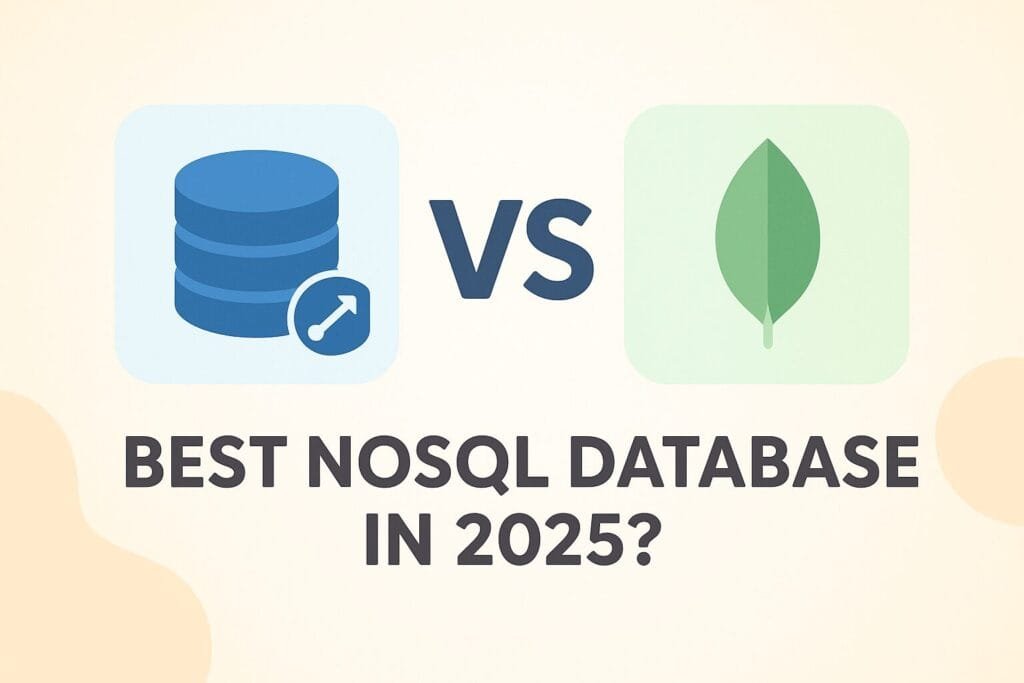Choosing the right NoSQL database in 2025 is more important than ever. With the growing demand for scalable, flexible, and high-performance databases, DynamoDB vs MongoDB has become a trending debate among developers, startups, and enterprises. Both offer outstanding features, but each comes with strengths and trade-offs depending on your project needs.
In this article, we will compare Amazon DynamoDB and MongoDB in detail, looking at performance, scalability, pricing, ecosystem, and use cases. By the end, you will know which NoSQL database is the best fit for your application in 2025.

What is DynamoDB?
Amazon DynamoDB is a fully managed NoSQL database service offered by AWS. It provides single-digit millisecond performance, built-in scalability, and seamless integration with the AWS ecosystem. DynamoDB is serverless, meaning developers do not need to worry about provisioning, scaling, or maintaining servers.
What is MongoDB?
MongoDB is an open-source NoSQL database that stores data in a flexible, JSON-like format. It allows developers to handle unstructured and semi-structured data with ease. MongoDB can be self-hosted or used as a fully managed service through MongoDB Atlas. Its flexibility and developer-friendly design have made it one of the most popular databases in the world.
Key Differences: DynamoDB vs MongoDB
The following table summarizes the most important differences between DynamoDB and MongoDB:
| Feature | DynamoDB | MongoDB |
|---|---|---|
| Deployment | Fully managed on AWS (serverless) | Self-hosted or managed with MongoDB Atlas |
| Data Model | Key-Value & Document | Document-oriented (JSON-like) |
| Performance | Single-digit millisecond response | High performance with indexes, sharding |
| Scalability | Automatic scaling (on-demand or provisioned) | Sharding required for horizontal scaling |
| Pricing | Pay-per-request or provisioned capacity | Free open-source version, Atlas with flexible pricing |
| Best Use Case | High-traffic apps, IoT, gaming, serverless apps | Content management, analytics, e-commerce |
Performance and Scalability
DynamoDB is optimized for extremely low-latency workloads. Its serverless architecture automatically scales to handle millions of requests per second. This makes it ideal for mission-critical applications where performance is non-negotiable.
MongoDB also offers high performance but requires proper index management and sharding for scaling large workloads. It gives developers more control, but this comes at the cost of additional configuration and maintenance.
Pricing and Cost Management
One of the biggest differences between DynamoDB and MongoDB is pricing. DynamoDB uses a pay-as-you-go model where you pay for read/write capacity and storage. For unpredictable workloads, this can be cost-efficient. However, for consistently high usage, costs can escalate quickly.
MongoDB is open-source, meaning you can use it for free if self-hosted. With MongoDB Atlas, pricing depends on clusters, storage, and features. For startups and developers who want full control and flexibility, MongoDB might be the more budget-friendly choice.
Developer Ecosystem
DynamoDB integrates seamlessly with the AWS ecosystem, making it an attractive choice for businesses already using AWS services. Its API is straightforward, but the data model can feel restrictive compared to MongoDB’s flexible schema design.
MongoDB has a vast ecosystem with strong community support, libraries, and integration with modern frameworks. Its flexibility in handling diverse data structures makes it highly popular among developers building web, mobile, and data-driven applications.
Use Cases in 2025
- DynamoDB: Gaming apps, serverless applications, e-commerce platforms requiring high availability, IoT solutions.
- MongoDB: CMS systems, real-time analytics, mobile apps, and startups needing rapid development cycles.
Which One Should You Choose in 2025?
The choice between DynamoDB and MongoDB in 2025 depends on your project requirements:
- If you need seamless scalability, integration with AWS, and serverless architecture: Choose DynamoDB.
- If you want flexibility, open-source availability, and control over infrastructure: Choose MongoDB.
Conclusion
Both DynamoDB and MongoDB are powerful NoSQL databases, but their strengths align with different needs. DynamoDB shines in AWS-based, high-performance environments, while MongoDB offers flexibility and developer freedom. In 2025, your decision should be based on workload type, budget, and ecosystem preference.
By understanding the strengths and trade-offs of each, you can confidently select the best NoSQL database for your application in 2025.

